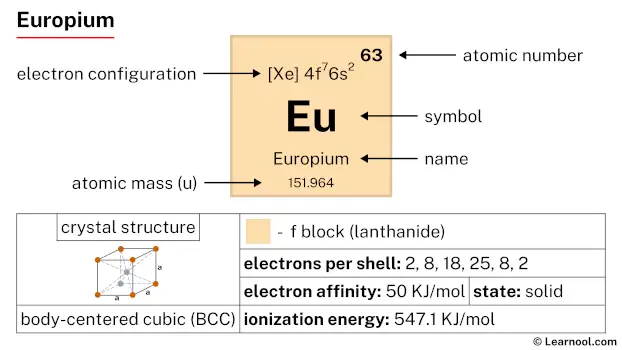
Europium (Eu) is a chemical element of the periodic table, located in the period 6, and has the atomic number 63. It is the seventh element in the lanthanide series. It is a soft, silvery-white metal, which is named after Europe. It is the softest and the most reactive element in the lanthanide series and is counted as one of the rare earth elements.
On periodic table
| group | ⇨ | 1 | 2 | 3 | 4 | 5 | 6 | 7 | 8 | 9 | 10 | 11 | 12 | 13 | 14 | 15 | 16 | 17 | 18 |
| period | ⇩ | ||||||||||||||||||
| 1 | 1 H 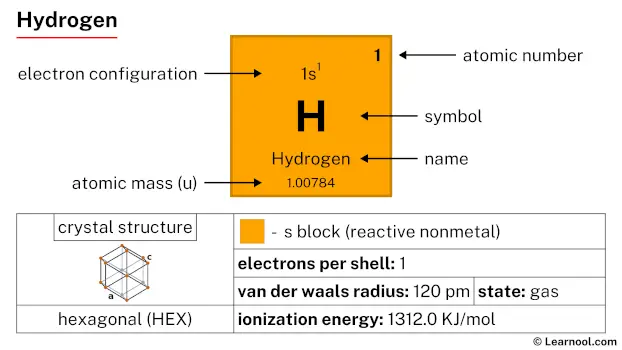 Hydrogen |
2 He  Helium |
|||||||||||||||||
| 2 | 3 Li  Lithium |
4 Be 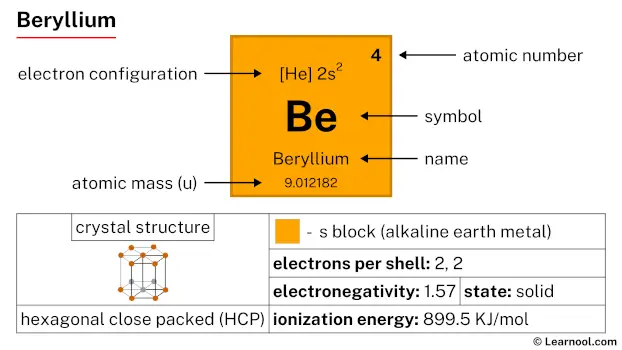 Beryllium |
5 B 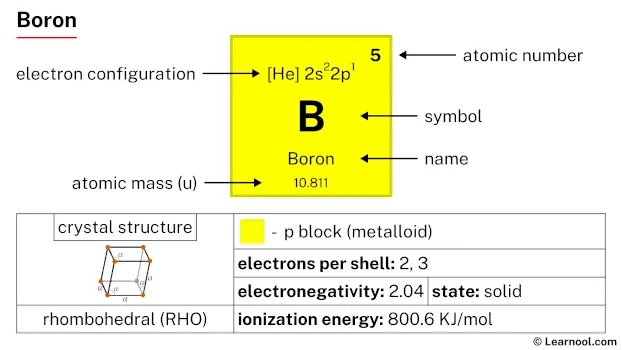 Boron |
6 C  Carbon |
7 N 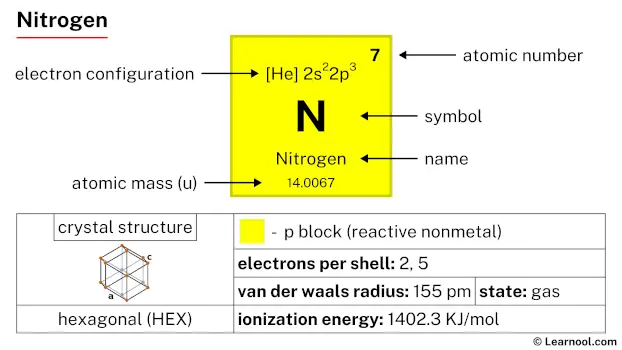 Nitrogen |
8 O 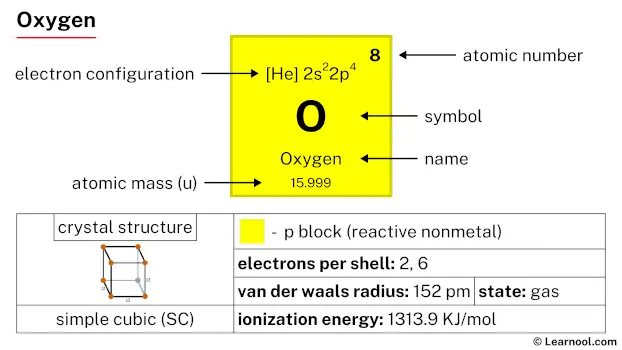 Oxygen |
9 F 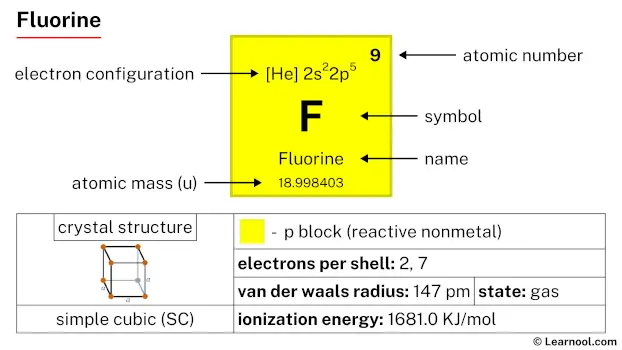 Fluorine |
10 Ne 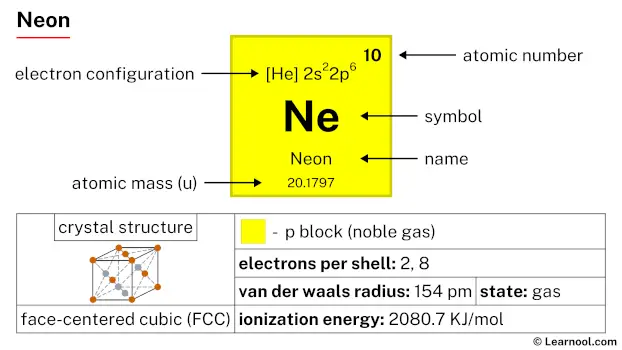 Neon |
|||||||||||
| 3 | 11 Na 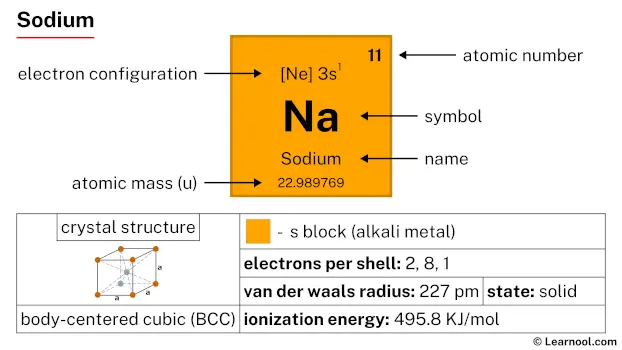 Sodium |
12 Mg 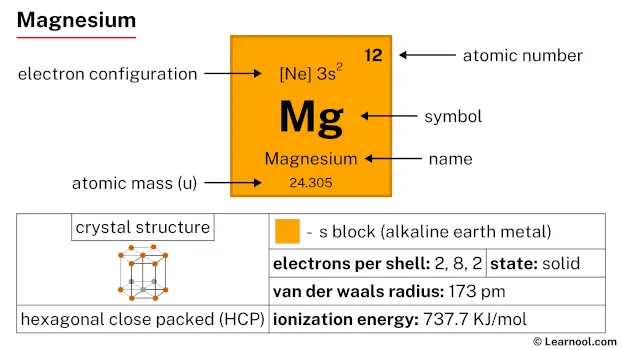 Magnesium |
13 Al  Aluminium |
14 Si Silicon |
15 P 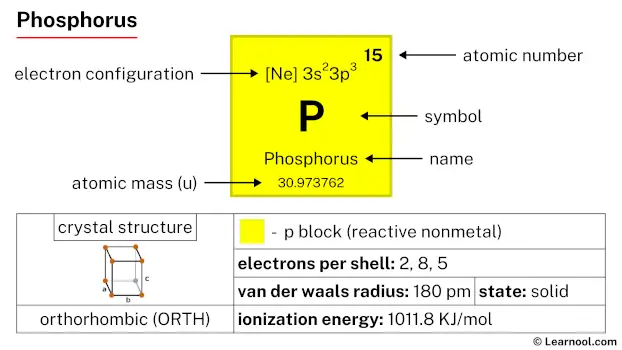 Phosphorus |
16 S 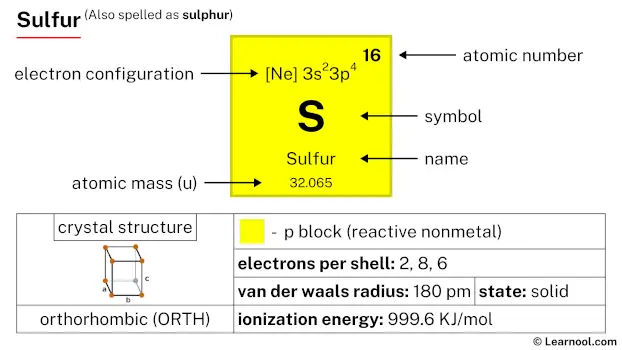 Sulfur |
17 Cl 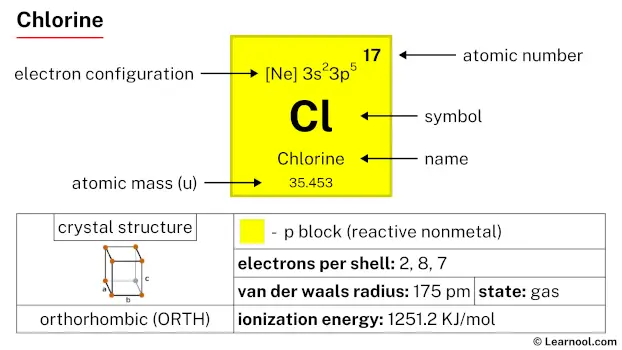 Chlorine |
18 Ar 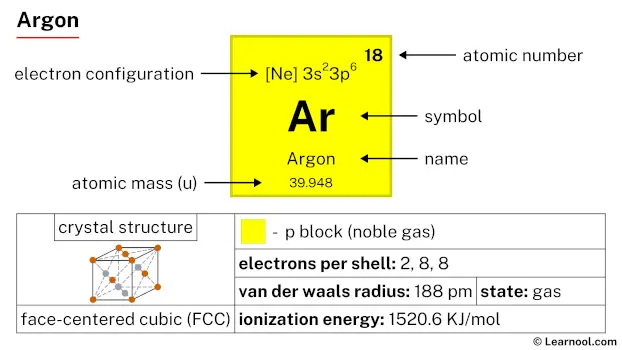 Argon |
|||||||||||
| 4 | 19 K 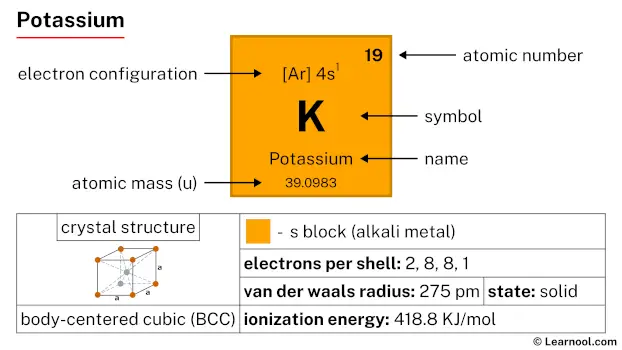 Potassium |
20 Ca 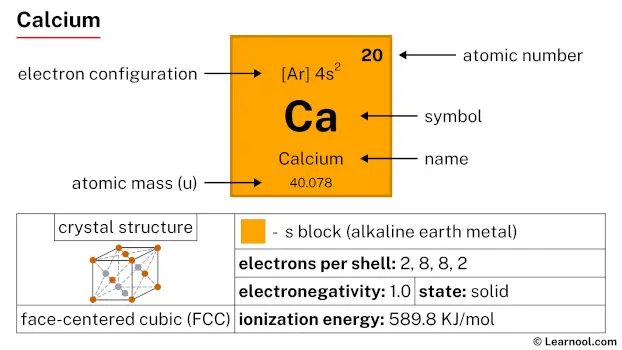 Calcium |
21 Sc 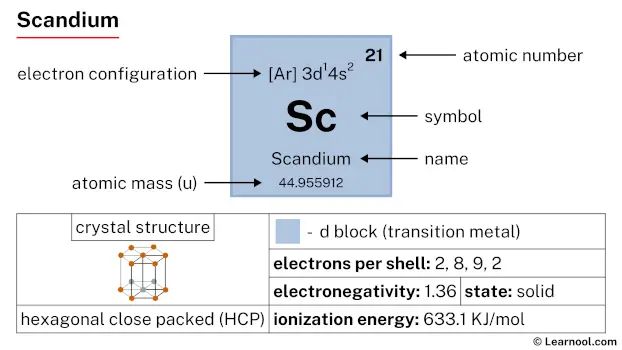 Scandium |
22 Ti 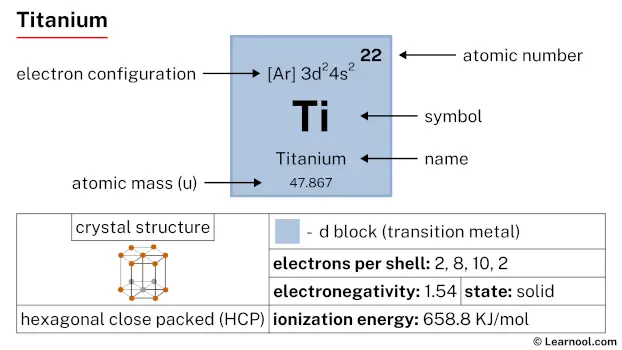 Titanium |
23 V 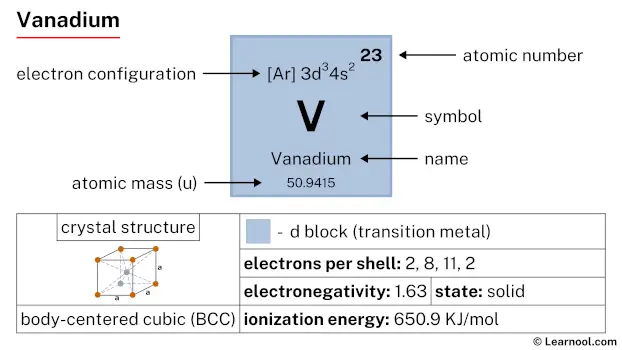 Vanadium |
24 Cr 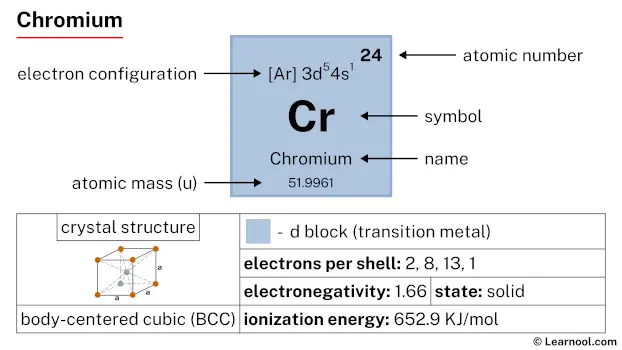 Chromium |
25 Mn 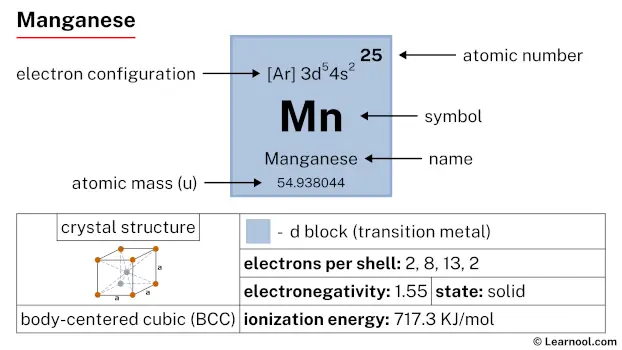 Manganese |
26 Fe 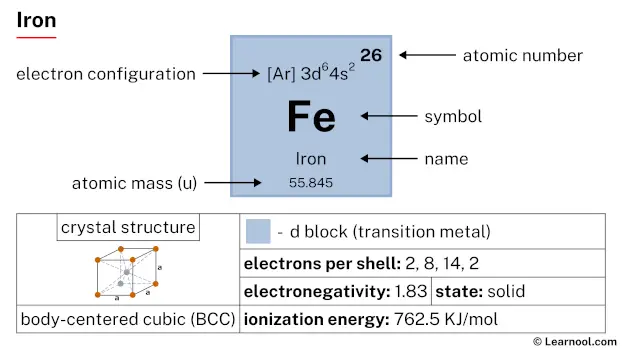 Iron |
27 Co 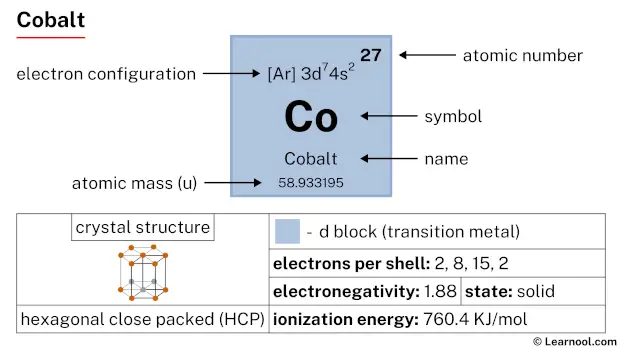 Cobalt |
28 Ni 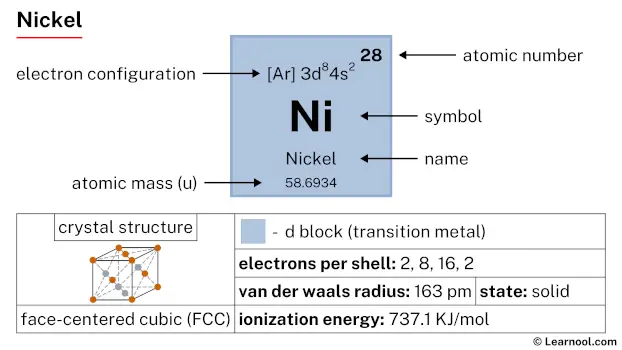 Nickel |
29 Cu 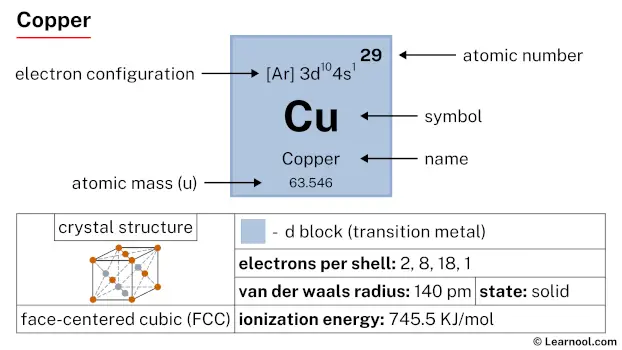 Copper |
30 Zn  Zinc |
31 Ga 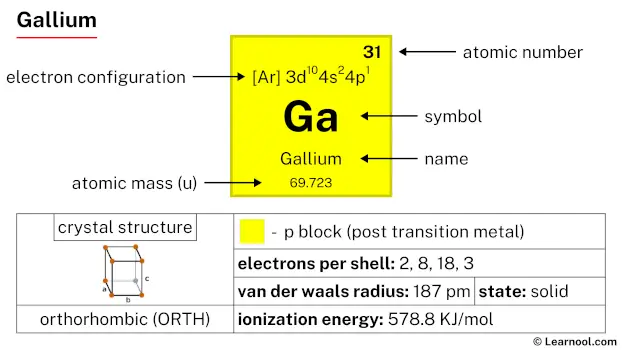 Gallium |
32 Ge 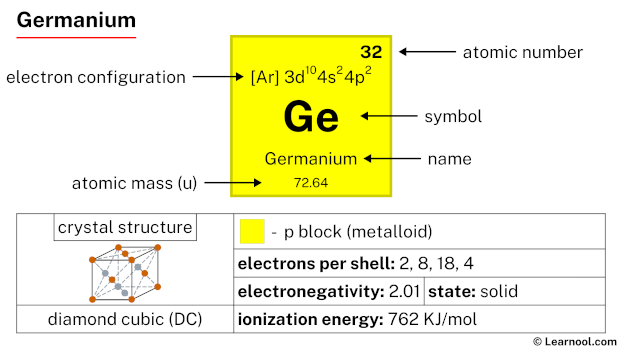 Germanium |
33 As 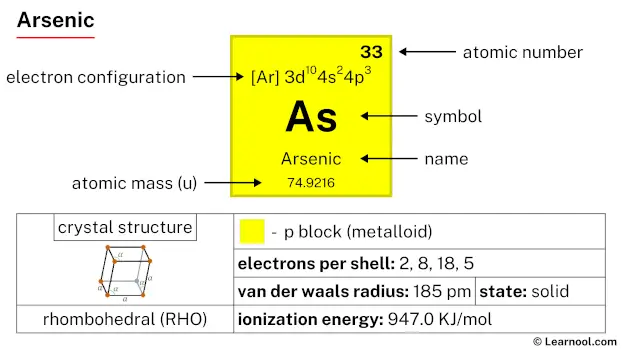 Arsenic |
34 Se 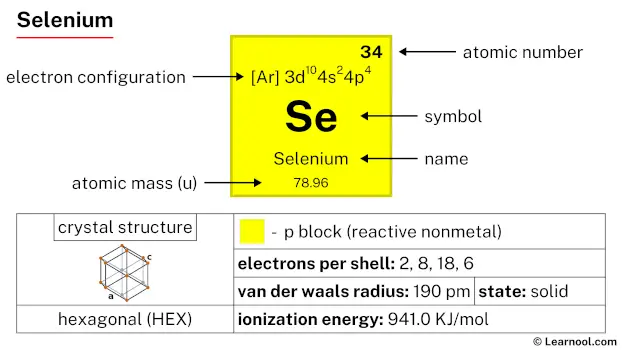 Selenium |
35 Br 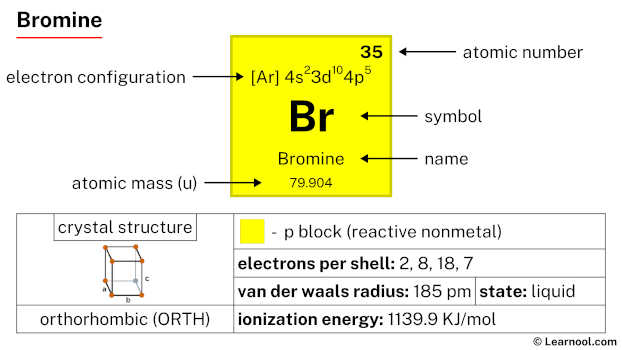 Bromine |
36 Kr  Krypton |
|
| 5 | 37 Rb 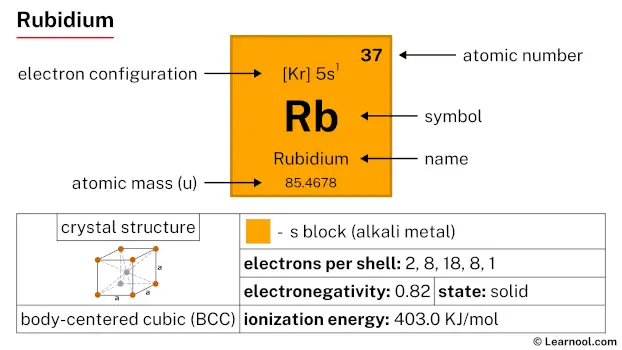 Rubidium |
38 Sr 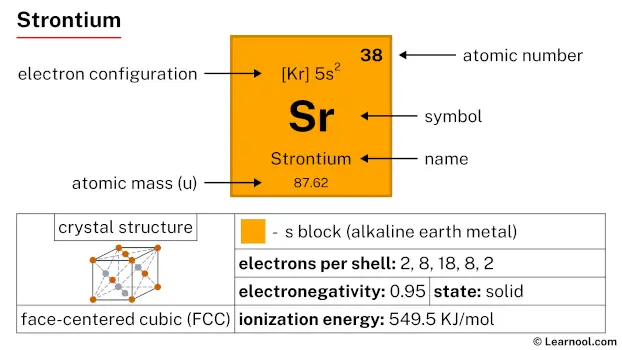 Strontium |
39 Y 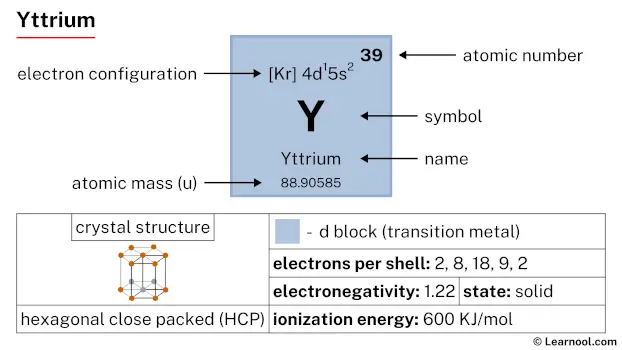 Yttrium |
40 Zr 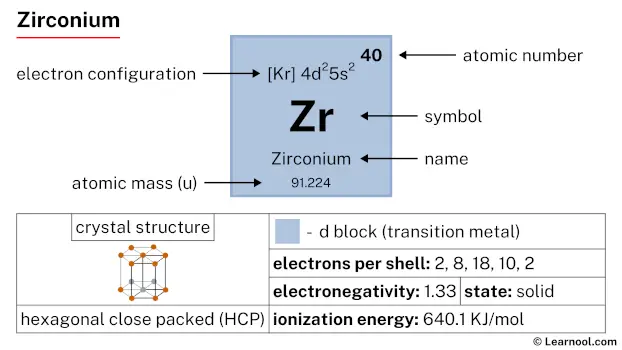 Zirconium |
41 Nb 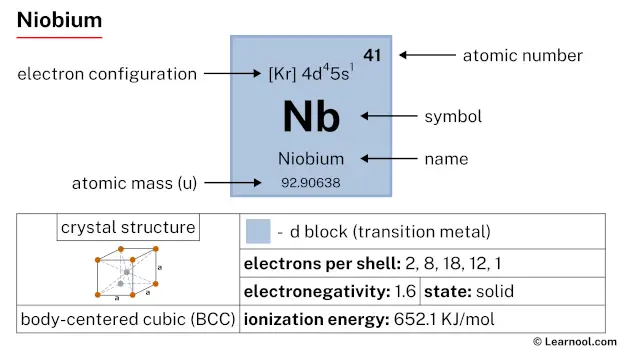 Niobium |
42 Mo 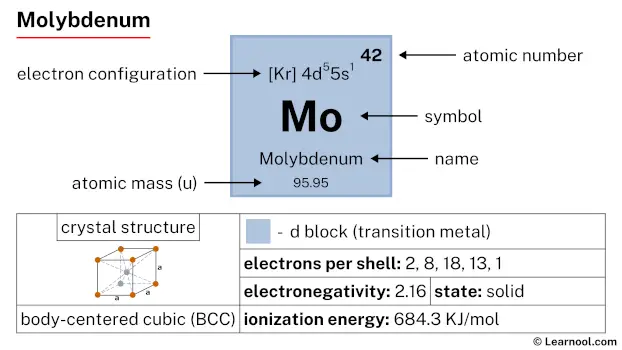 Molybdenum |
43 Tc 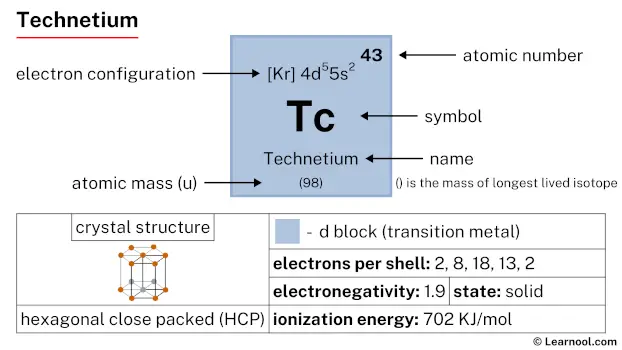 Technetium |
44 Ru 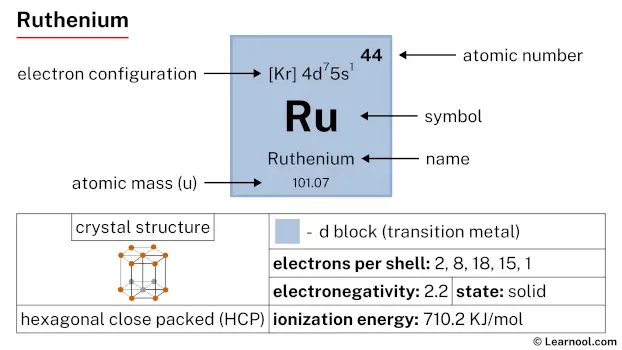 Ruthenium |
45 Rh 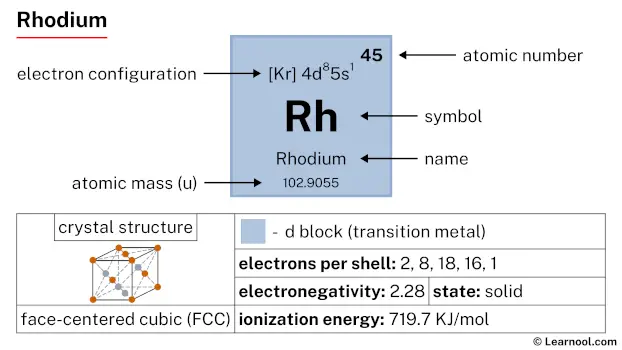 Rhodium |
46 Pd  Palladium |
47 Ag  Silver |
48 Cd 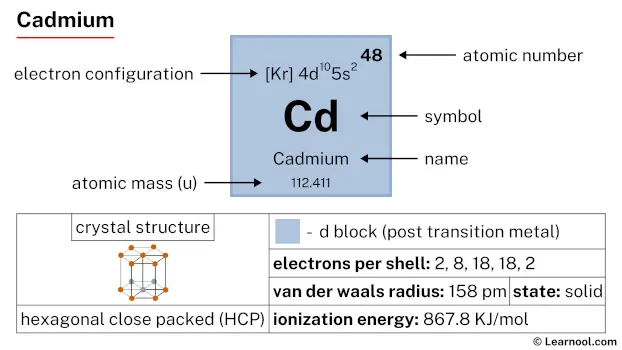 Cadmium |
49 In 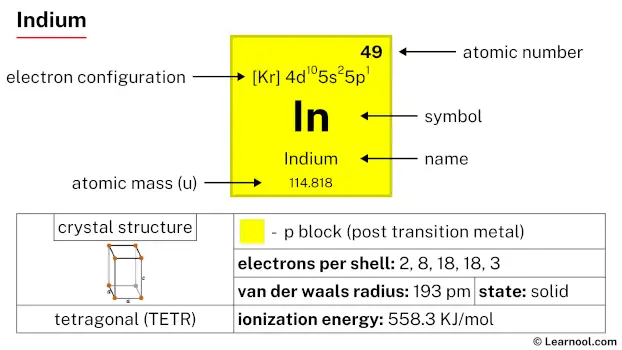 Indium |
50 Sn 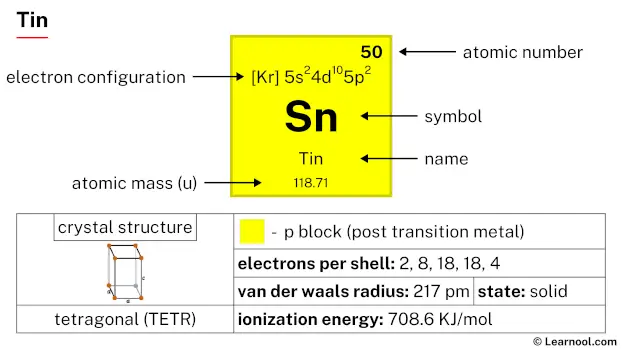 Tin |
51 Sb 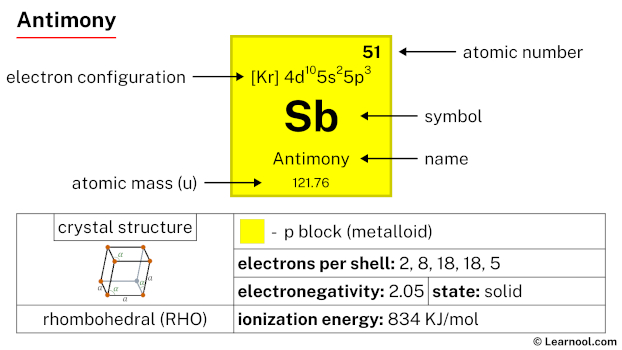 Antimony |
52 Te 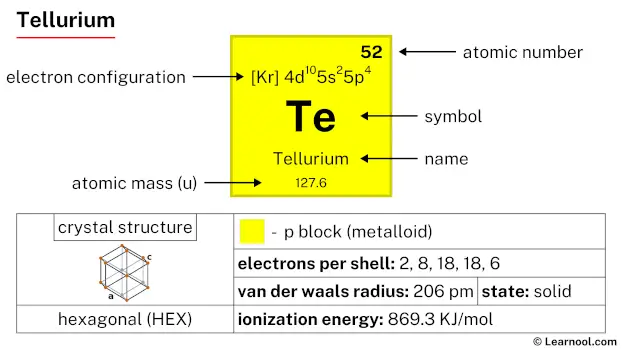 Tellurium |
53 I 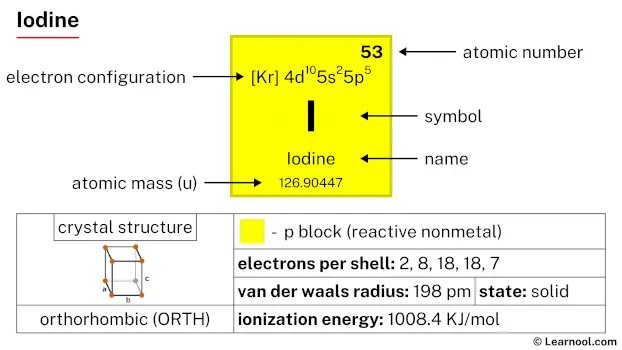 Iodine |
54 Xe 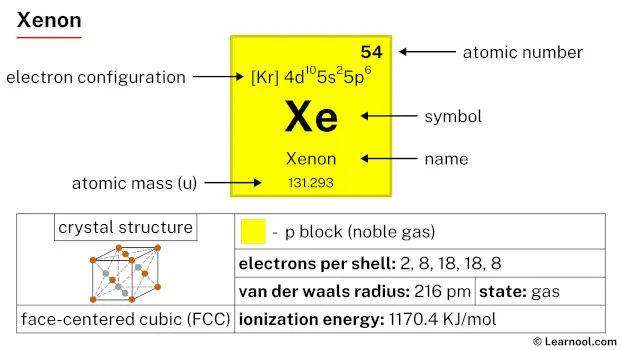 Xenon |
|
| 6 | 55 Cs 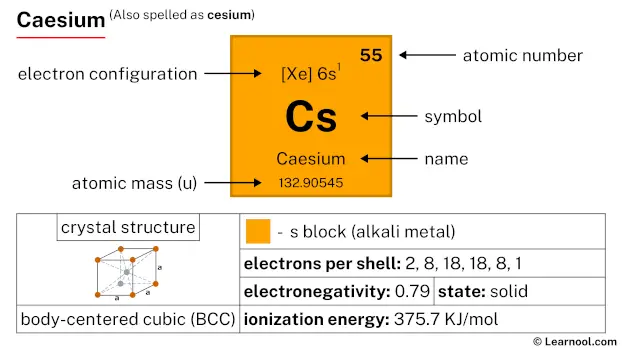 Caesium |
56 Ba 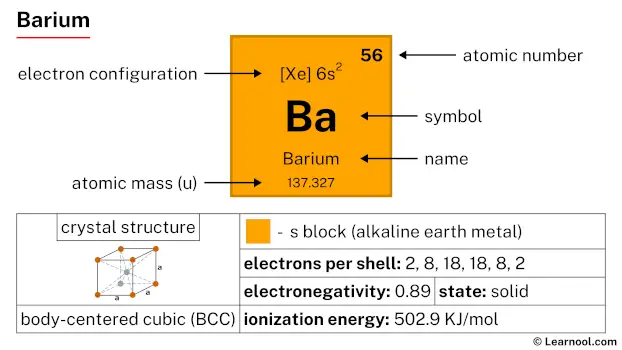 Barium |
72 Hf 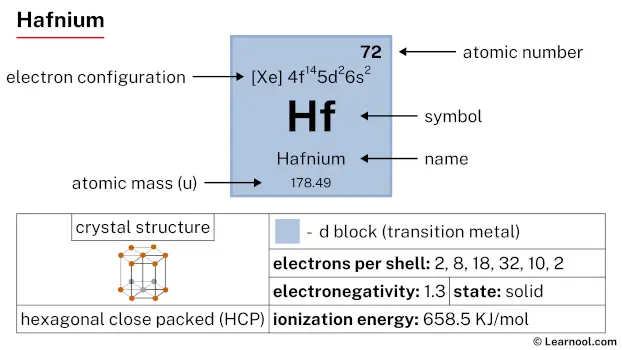 Hafnium |
73 Ta 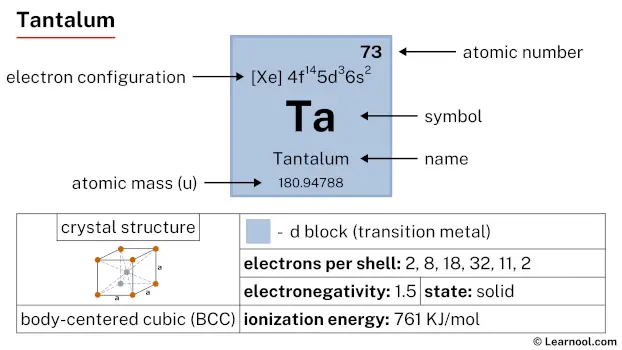 Tantalum |
74 W 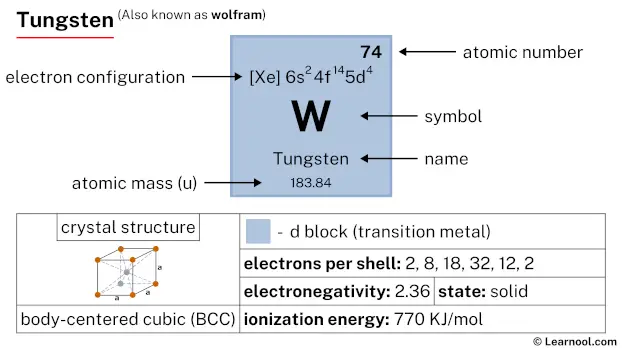 Tungsten |
75 Re 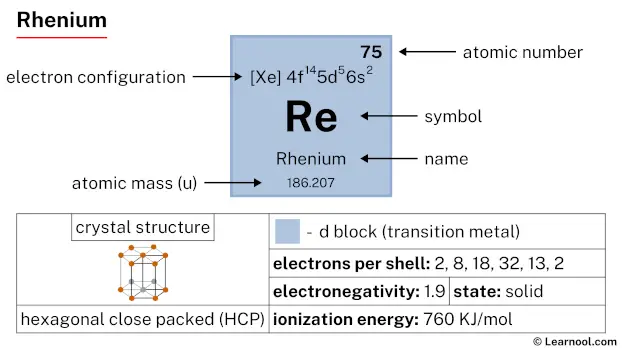 Rhenium |
76 Os 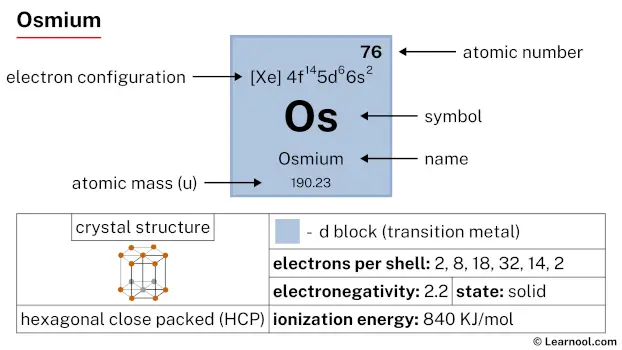 Osmium |
77 Ir 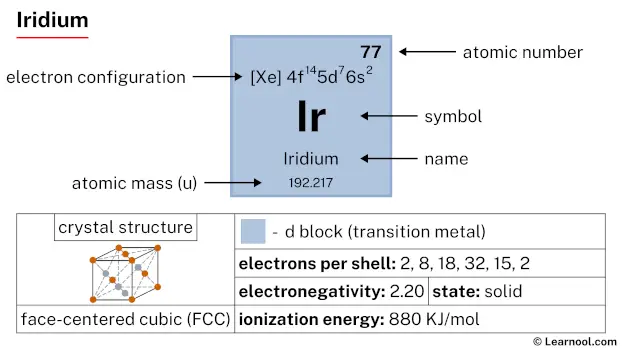 Iridium |
78 Pt  Platinum |
79 Au  Gold |
80 Hg 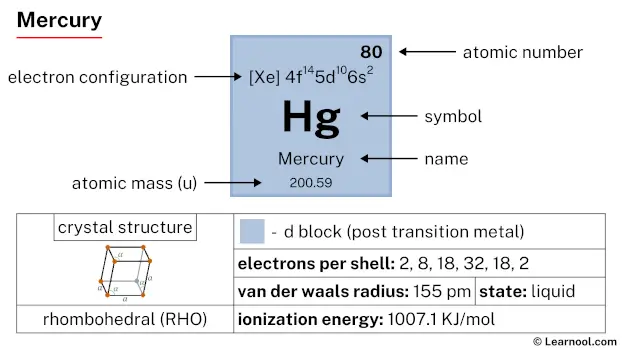 Mercury |
81 Tl 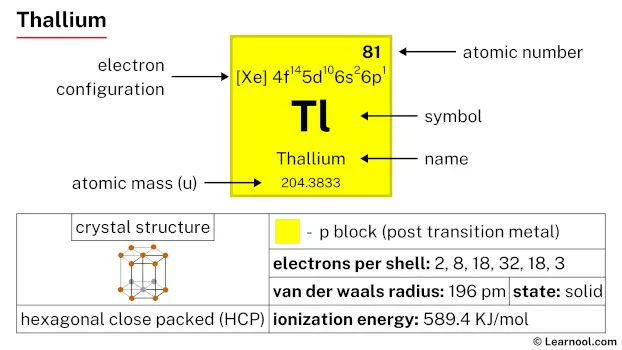 Thallium |
82 Pb  Lead |
83 Bi 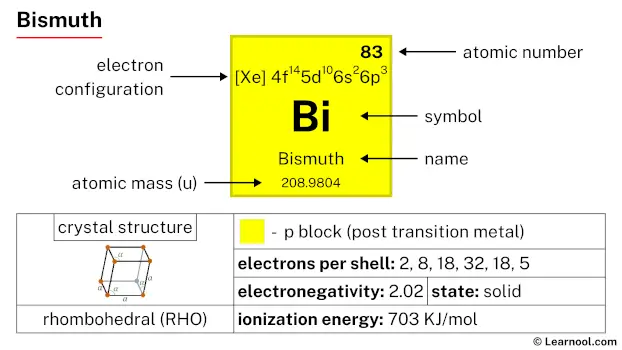 Bismuth |
84 Po 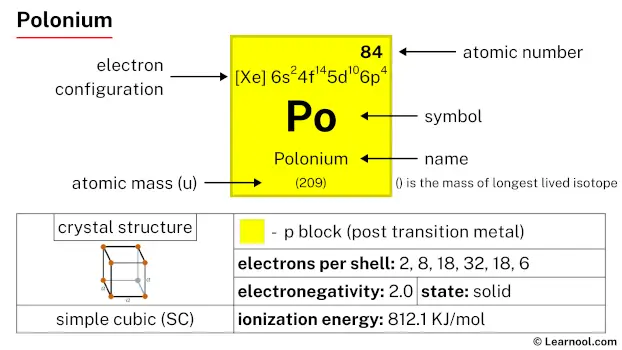 Polonium |
85 At 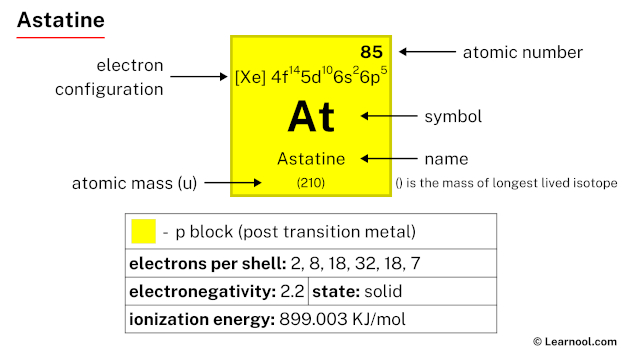 Astatine |
86 Rn 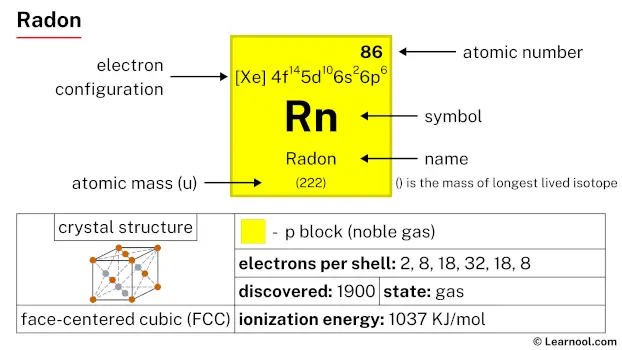 Radon |
||
| 7 | 87 Fr 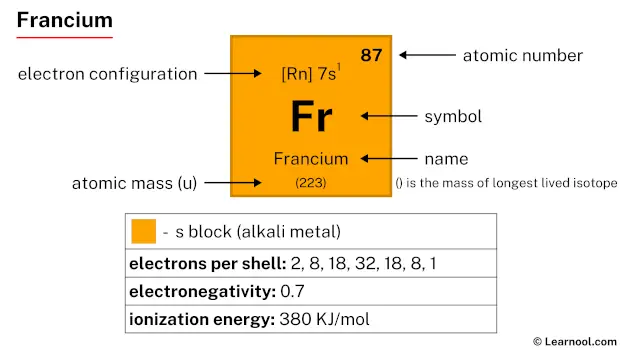 Francium |
88 Ra 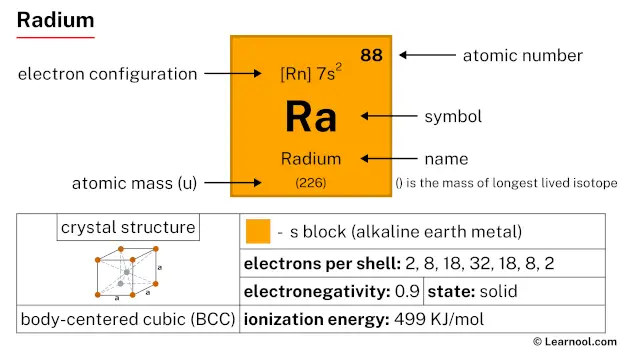 Radium |
104 Rf 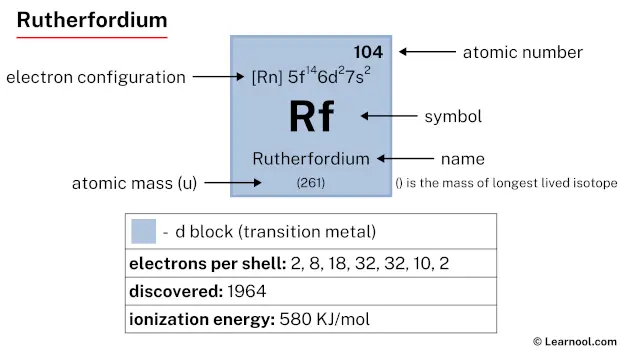 Rutherfordium |
105 Db 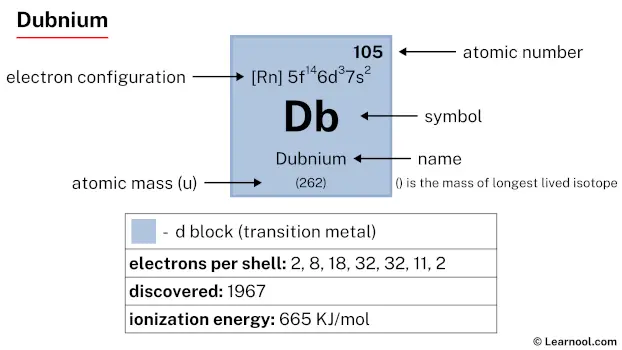 Dubnium |
106 Sg 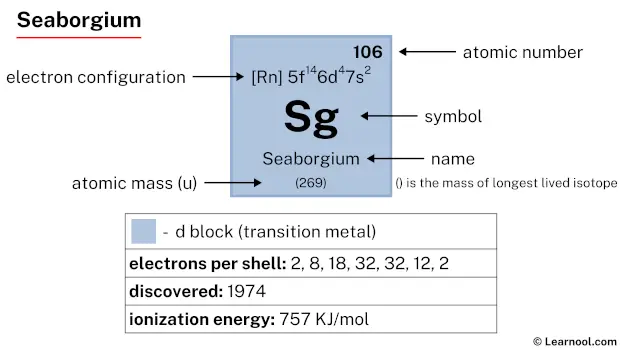 Seaborgium |
107 Bh 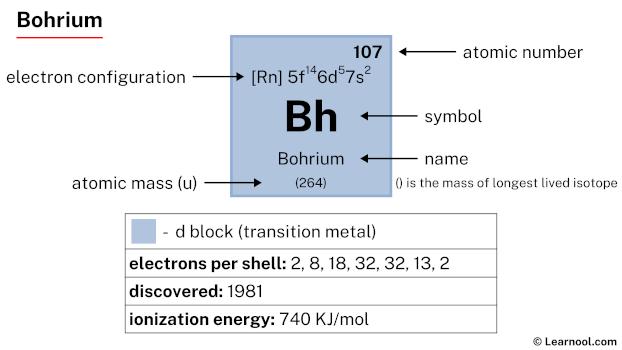 Bohrium |
108 Hs 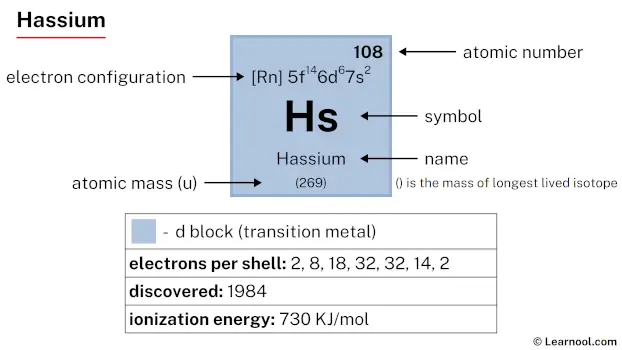 Hassium |
109 Mt 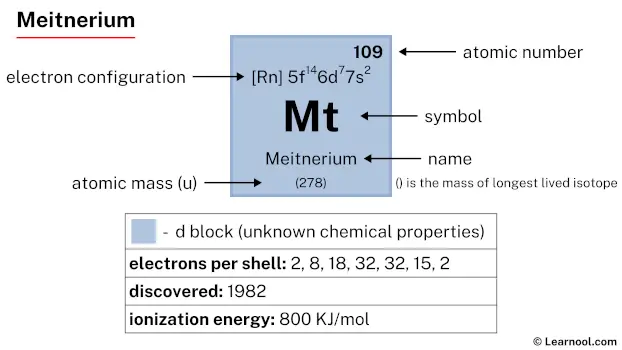 Meitnerium |
110 Ds 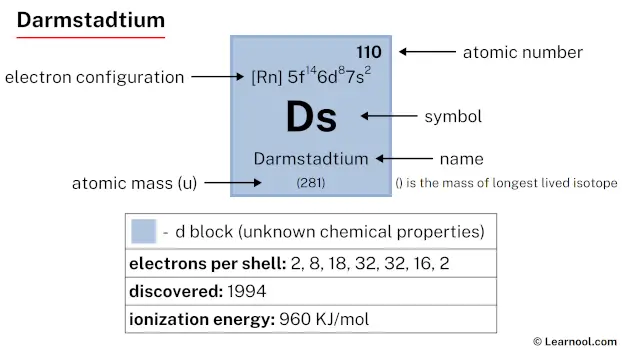 Darmstadtium |
111 Rg 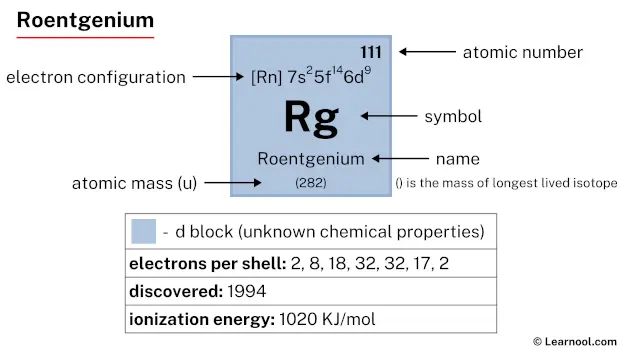 Roentgenium |
112 Cn  Copernicium |
113 Nh 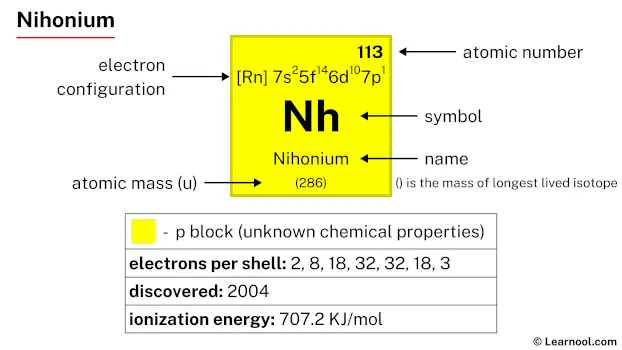 Nihonium |
114 Fl 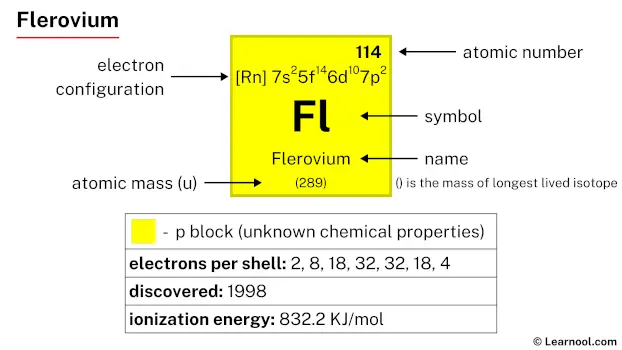 Flerovium |
115 Mc 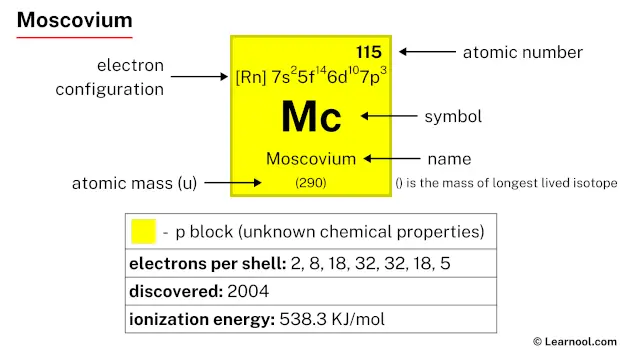 Moscovium |
116 Lv 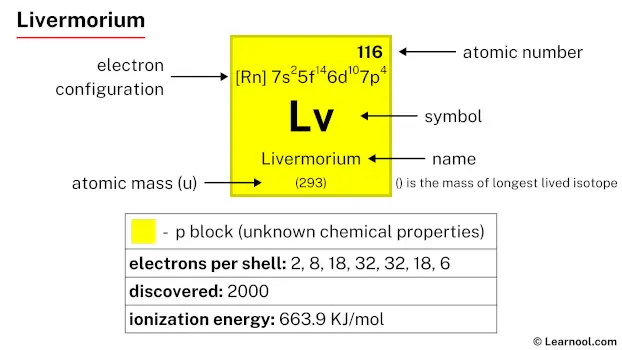 Livermorium |
117 Ts 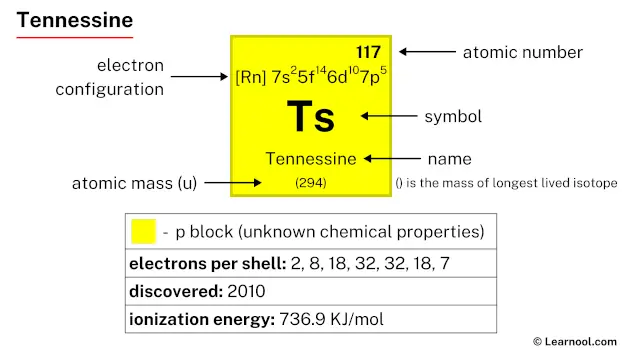 Tennessine |
118 Og 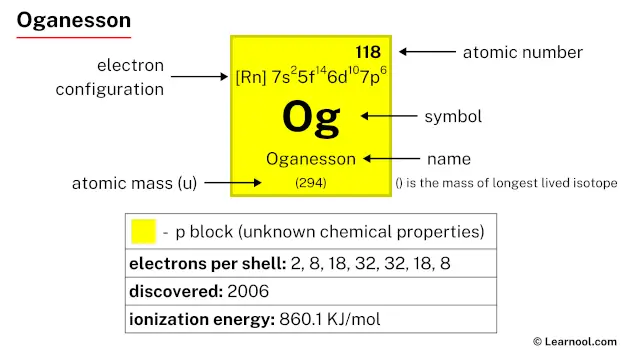 Oganesson |
||
| 57 La 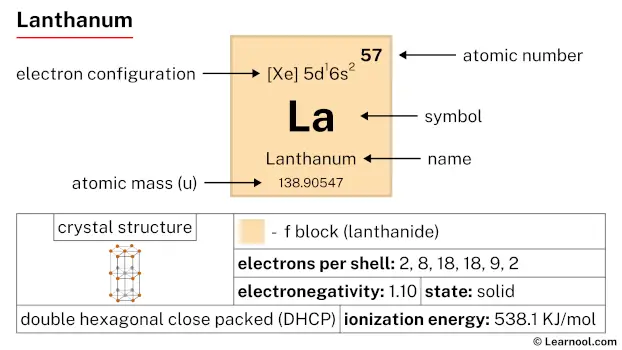 Lanthanum |
58 Ce 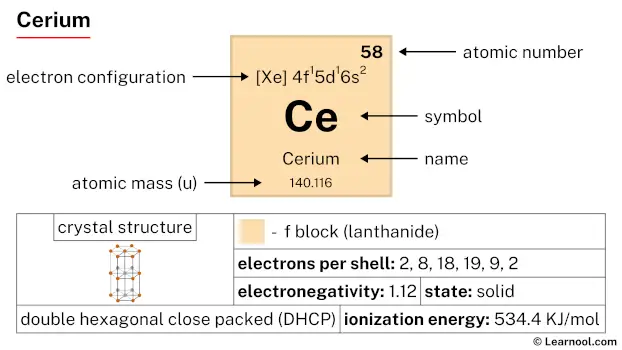 Cerium |
59 Pr 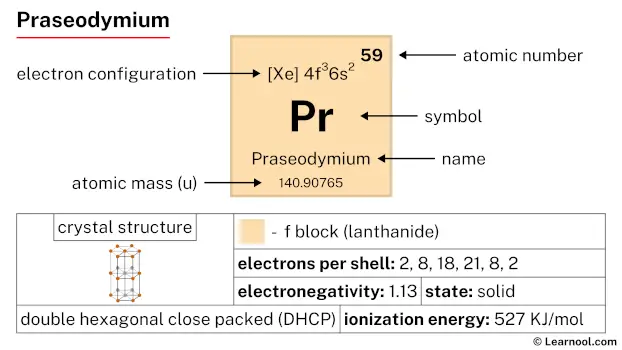 Praseodymium |
60 Nd 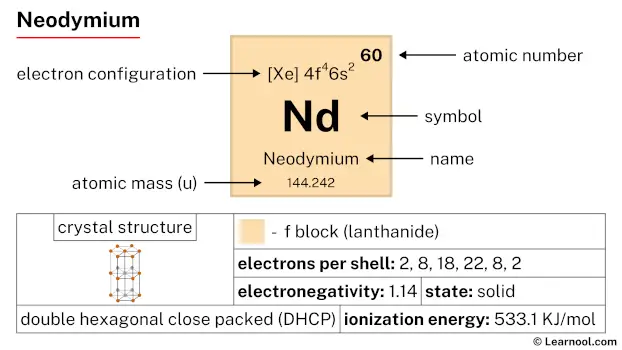 Neodymium |
61 Pm 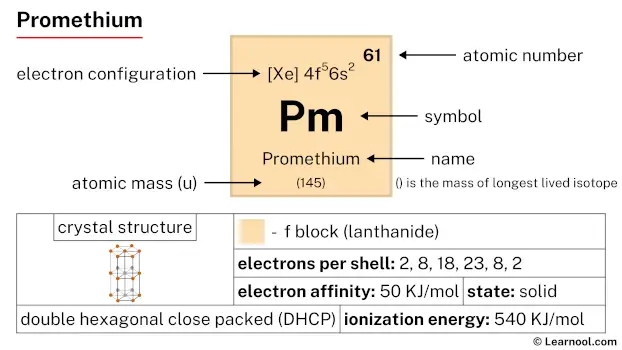 Promethium |
62 Sm 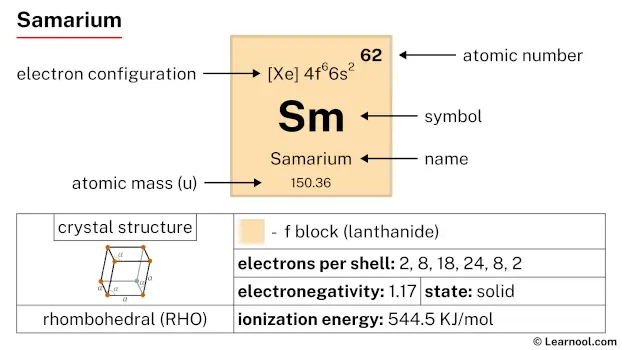 Samarium |
63 Eu Europium |
64 Gd 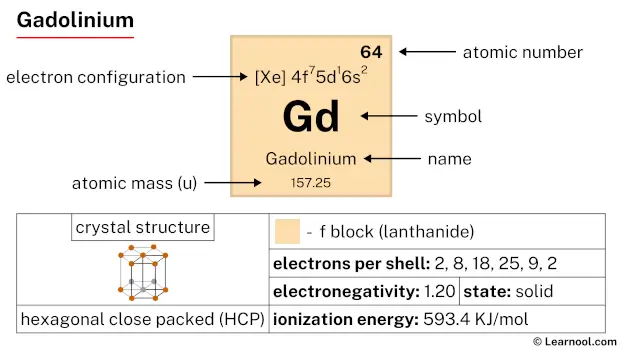 Gadolinium |
65 Tb 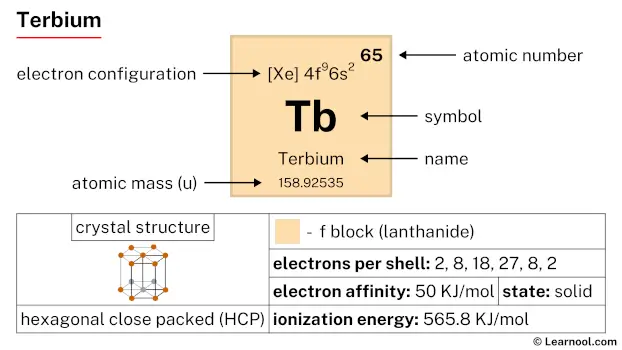 Terbium |
66 Dy 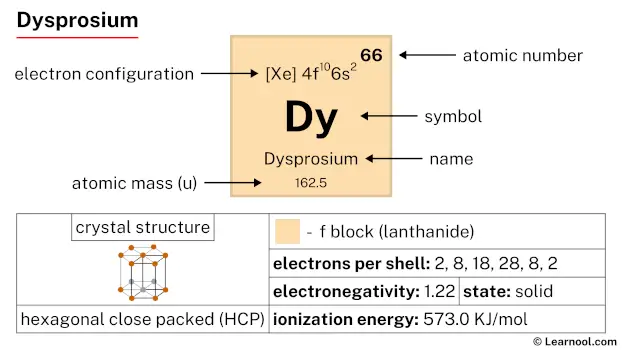 Dysprosium |
67 Ho 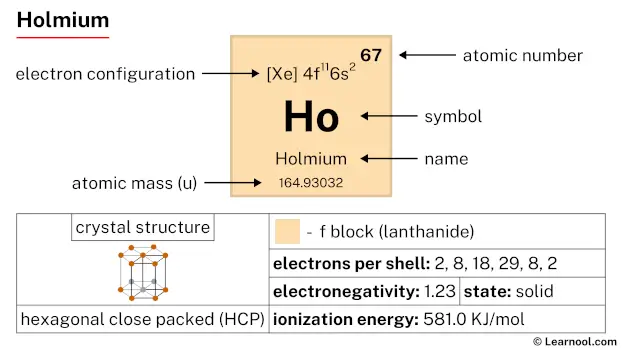 Holmium |
68 Er 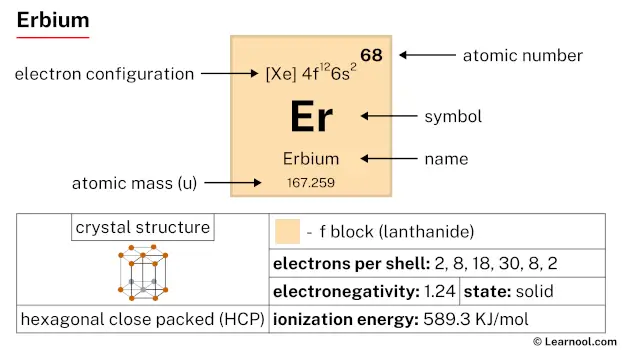 Erbium |
69 Tm 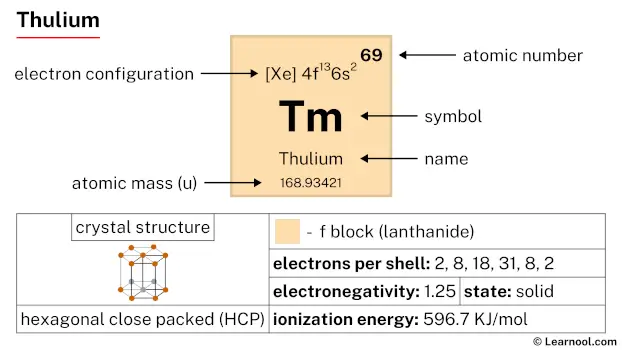 Thulium |
70 Yb 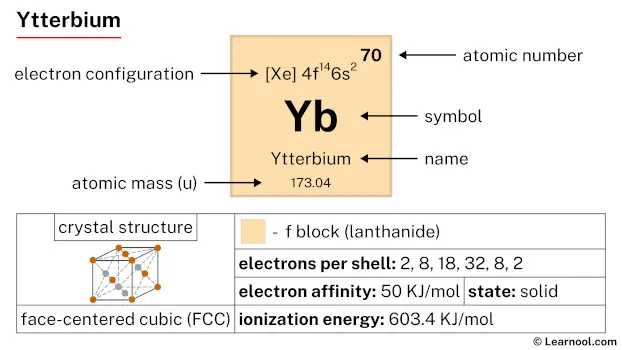 Ytterbium |
71 Lu 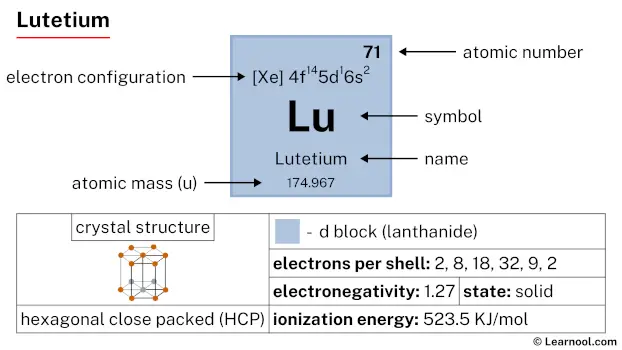 Lutetium |
|||||
| 89 Ac 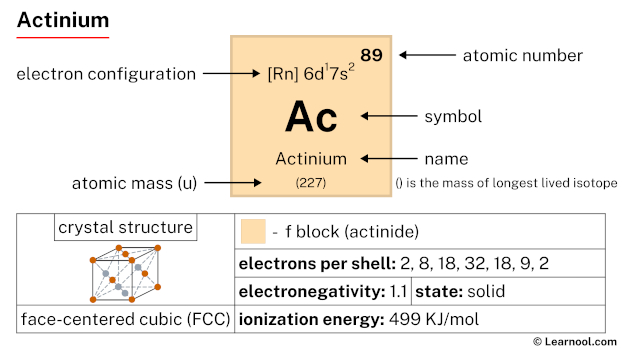 Actinium |
90 Th 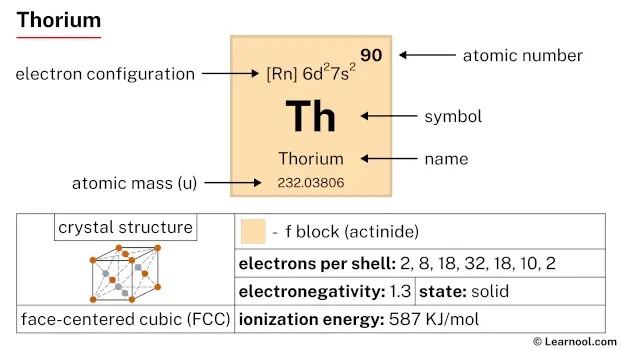 Thorium |
91 Pa 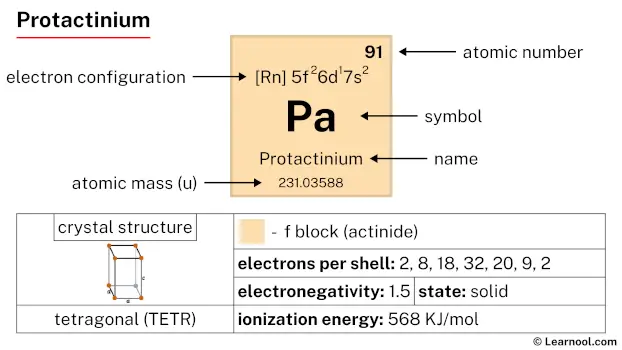 Protactinium |
92 U 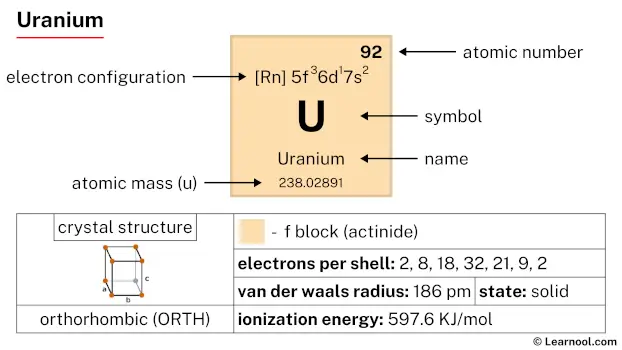 Uranium |
93 Np 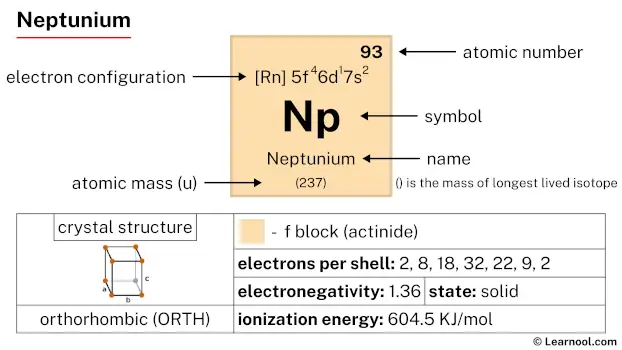 Neptunium |
94 Pu 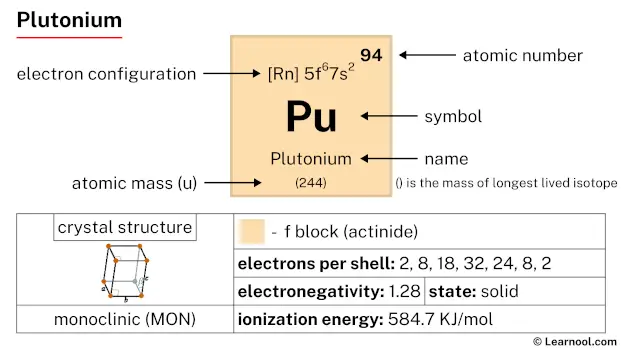 Plutonium |
95 Am  Americium |
96 Cm 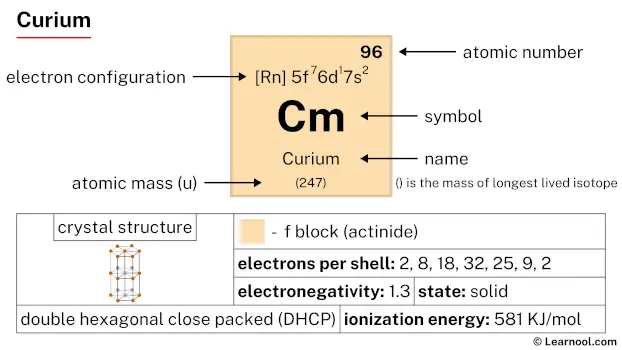 Curium |
97 Bk 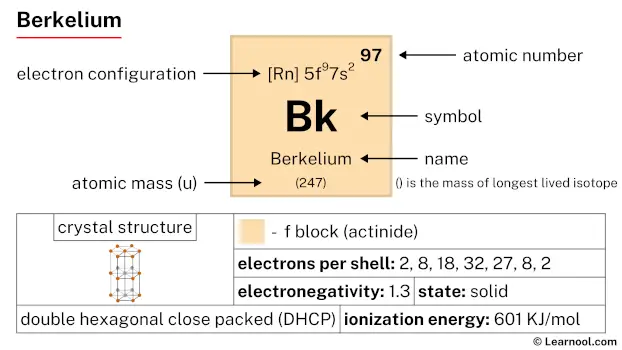 Berkelium |
98 Cf 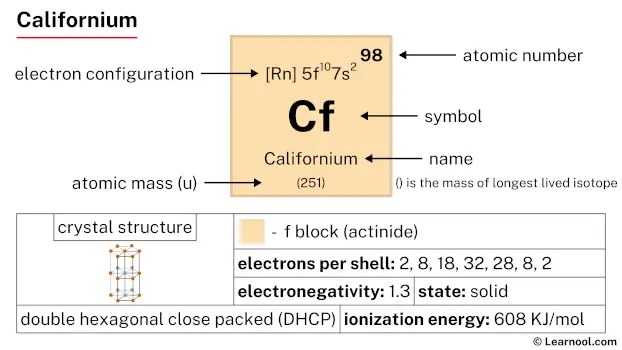 Californium |
99 Es 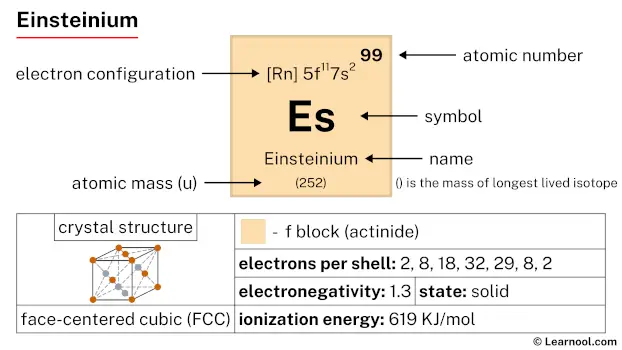 Einsteinium |
100 Fm 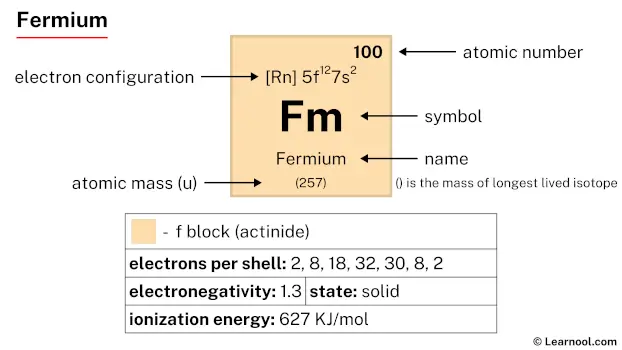 Fermium |
101 Md 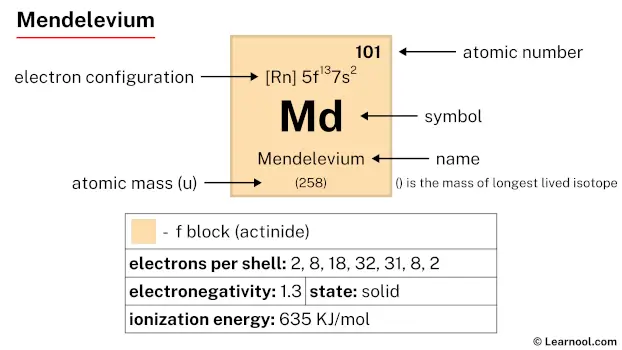 Mendelevium |
102 No 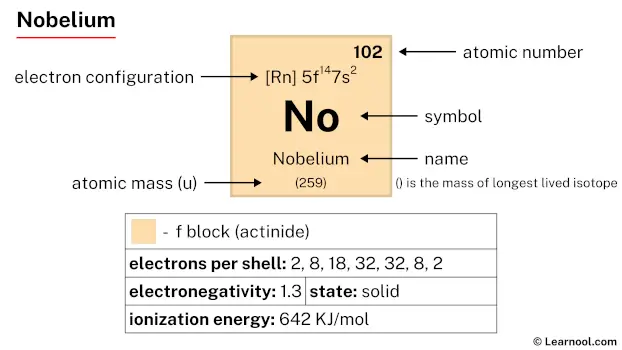 Nobelium |
103 Lr 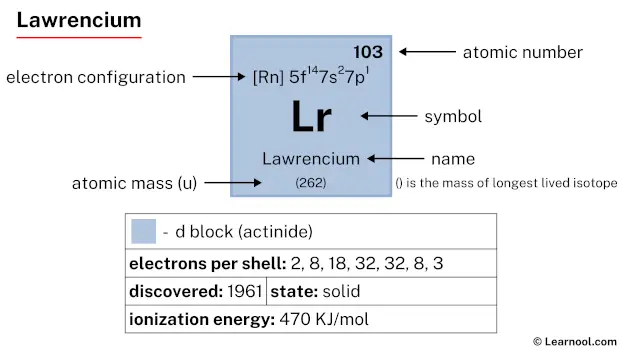 Lawrencium |
|||||
| – f block |
Europium (Eu) is located on the periodic table in the lanthanide series, which is a group of elements located at the bottom of the table. Specifically, in period 6, between samarium (Sm) and gadolinium (Gd).
Element information
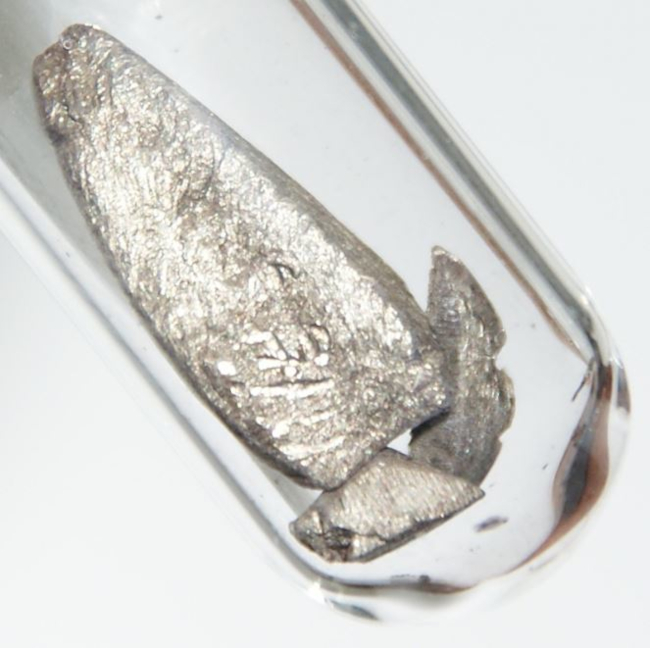 |
|
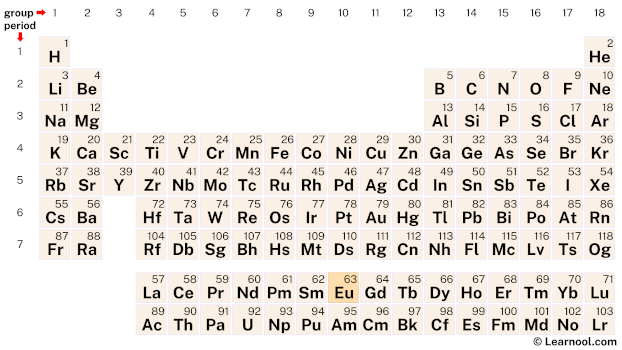 |
|
| Origin of name | named after Europe |
| Symbol | Eu |
| Atomic number (Z) | 63 |
| Atomic mass | 151.964 u |
| Block | f-block |
| Period | 6 |
| Classification | Lanthanide |
| Atomic radius | 180 pm |
| Covalent radius | 198±6 pm |
| Melting point | 826 ℃, 1519 ℉, 1099 K |
| Boiling point | 1802 ℃, 2784 ℉, 1802 K |
| Electron configuration | [Xe] 4f7 6s2 |
| Electrons per shell | 2, 8, 18, 25, 8, 2 |
| Learn how to draw: Europium Bohr model | |
| Crystal structure | Body-centered cubic (bcc) |
| Phase at r.t | Solid |
| Density near r.t | 5.244 g/cm3 |
| Main isotopes | Europium-153 |
| Natural occurrence | Primordial |
| Oxidation state | +2, +3 |
| Electronegativity (Pauling scale) | 1.2 |
| Protons Neutrons Electrons |
63 89 63 |
| Learn how to find: Europium protons neutrons electrons | |
| CAS number | 7440-53-1 |
| Discovered by | Eugène-Anatole Demarçay in 1901 |
History
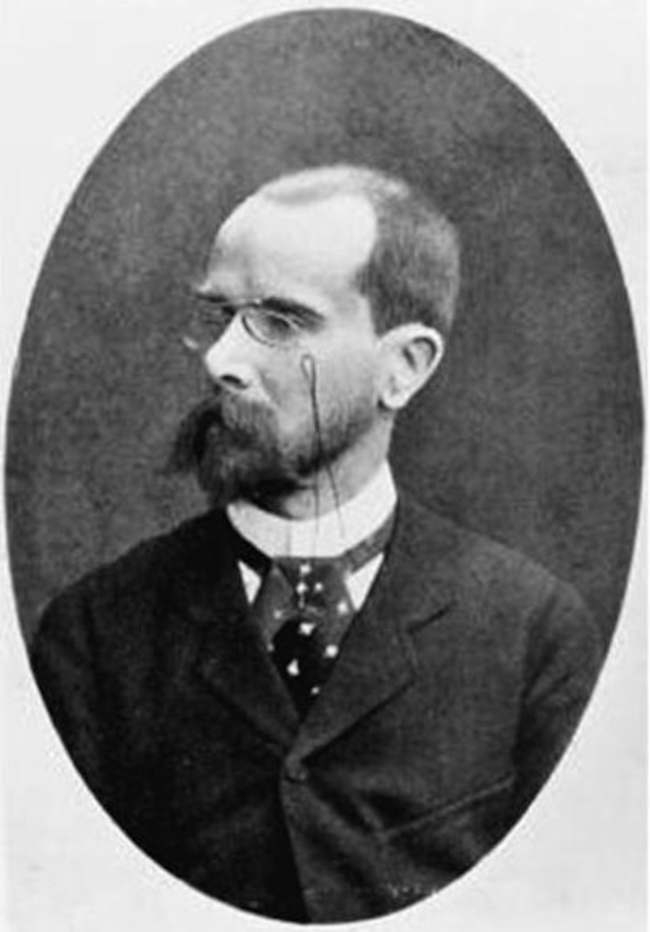
Europium, a rare earth element, was first known to chemists in the late 1800s. It wasn’t until 1892 that French chemist Paul Émile Lecoq de Boisbaudran obtained basic fractions from samarium-gadolinium concentrates with spectral lines that couldn’t be attributed to either samarium or gadolinium. However, Eugène-Anatole Demarçay, another French chemist, is generally credited with discovering europium. In 1896, Demarçay observed some contamination while studying samples of samarium, which led him to suspect the presence of an unknown element. He successfully isolated the new element in 1901 and named it “europium” after the continent Europe.
The discovery of europium proved to be of great importance in the color television industry, which was just starting to emerge in the early 1960s. At the time, the red phosphor used in color TV screens was very weak, and the other phosphor colors had to be muted to maintain color balance. However, the discovery of the europium-doped yttrium orthovanadate red phosphor led to a brighter color TV picture, as it was no longer necessary to mute the other colors. As a result, there was a scramble for the limited supply of europium, with monazite processors competing for the rare element. Europium has continued to be used in the TV industry and computer monitors since then.
Europium has an interesting history, with chemists and scientists discovering its properties and potential applications over time. One story, related by Frank Spedding, a celebrated chemist, involved an elderly gentleman who approached him with an offer of several pounds of europium oxide. Spedding did not take the man seriously, but a package eventually arrived in the mail containing several pounds of genuine europium oxide. The elderly gentleman turned out to be Herbert Newby McCoy, who had developed a famous method of europium purification involving redox chemistry. This is just one example of the many contributions and discoveries that have been made in the study of europium over the years.
Occurrence and production
Europium is a rare earth element and is relatively abundant in the Earth’s crust. It is found in minerals such as monazite, bastnäsite, xenotime, and loparite. Monazite is the most important source of europium, with typical europium content of about 0.05%. Bastnäsite from the Mountain Pass mine in California, USA, has an unusually high europium content of about 0.1%, while the Bayan Obo mine in China has an even richer europium content of 0.2%.
The production of europium involves several steps, including mining, extraction, and purification. The primary source of europium is the mineral monazite, which is typically extracted through the process of acid cracking, followed by solvent extraction or ion exchange to separate the rare earth elements. The purified rare earth elements are then further processed through a series of chemical reactions to obtain europium metal or its oxide.
Europium is produced on a relatively small scale compared to other rare earth elements due to its low abundance and the difficulty of separating it from other rare earth elements. The largest producers of europium are currently China, the United States, and Brazil, with smaller amounts produced by other countries including India, Australia, and Russia. Europium is used primarily in the production of color phosphors for television and computer screens, as well as in nuclear reactors and certain types of lighting.
Properties
Europium is a soft, silvery-white metal that tarnishes quickly in air.
Europium is a rare earth metal that is moderately hard, malleable, and ductile, which means it can be easily shaped into thin sheets or drawn into wires.
It has a relatively low melting point and boiling point compared to most metals.
Europium is chemically reactive, particularly in its metallic state, and it readily forms compounds with oxygen, water, and acids.
Europium is a paramagnetic element, meaning it is weakly attracted to a magnetic field.
It has two stable isotopes, Eu-151 and Eu-153, with Eu-153 being slightly more abundant.
Europium has a unique red fluorescence that is used in the production of certain types of lighting and color displays.
Applications
Europium is commonly used as an activator in phosphors, which are materials that emit light in response to certain stimuli such as electron bombardment. In particular, europium is used in red and blue phosphors for color displays, including those used in computer monitors, televisions, and mobile devices.
Europium is used as a neutron absorber in nuclear reactors to help control the rate of nuclear fission. Specifically, europium-153 is used in the control rods of some reactors.
Europium is used as an activator in metal halide lamps, which are a type of high-intensity discharge lamp used for indoor and outdoor lighting. These lamps are known for their high efficiency, long life, and high color rendering index.
Europium is one of the rare earth elements that has unique magnetic properties. It is used in the production of high-performance magnets, including those used in computer hard drives and other electronic devices.
Europium is used in the production of special glasses and ceramics that have unique optical properties. For example, europium-doped glass can be used as a radiation detector, while europium-doped ceramics can be used as scintillators for medical imaging.
Interesting facts
Europium is the most reactive of the rare earth elements.
It is a good absorber of neutrons and is used in the control rods of nuclear reactors.
Europium is the only rare earth element that has a stable isotope, which makes it useful in nuclear magnetic resonance (NMR) studies.
Its unique fluorescence properties have been used to authenticate banknotes and passports.
The red and blue phosphors based on europium are used in television and computer screens.
Europium was discovered by a French chemist, Eugène-Anatole Demarçay, in 1896 while analyzing the spectral lines of samarium.
Related
More elements
External links
- https://www.rsc.org/periodic-table/element/63/europium
- https://en.wikipedia.org/wiki/Europium
- https://www.britannica.com/science/europium
- https://www.chemicool.com/elements/europium.html
- https://pubchem.ncbi.nlm.nih.gov/element/Europium
- https://www.livescience.com/38186-europium.html
Deep
Learnool.com was founded by Deep Rana, who is a mechanical engineer by profession and a blogger by passion. He has a good conceptual knowledge on different educational topics and he provides the same on this website. He loves to learn something new everyday and believes that the best utilization of free time is developing a new skill.
